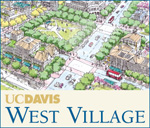 UC Davis and Development UC Davis and Development
I find it extremely ironic that UC Davis Magazine publishes such a wonderful article decrying the loss of vital agricultural farmland to development [winter ’05, “Disappearing Act”] when UC Davis, itself, is proposing to do the very same thing. UC Davis is planning to develop 225 acres of prime agricultural land west of Highway 113 and south of Russell Boulevard into a residential neighborhood titled “West Village” for 4,350 students, faculty and staff. This land has been called some of the most fertile soil in Yolo County and has long been used by UC Davis for important agricultural research. The land also provides many benefits to the community including a scenic open vista, a place for the Delta breezes to blow unhindered and cool us in the hot summer and a place for walkers and their dogs as well as joggers.
Currently the university is being sued by a group calling themselves West Davis Neighbors in at attempt to mitigate the impact of such a large development over prime ag land. The project has been approved by the UC Regents; however, as current rulings stand, UC is not liable to compensate for the adverse effects a project this size will create both environmentally and on the quality of life in Davis.
William Jewell
Associate Mass Spectrometry
Specialist, UC Davis
via e-mail
The editor responds: We addressed that very issue as part of our “Disappearing Act” feature, in an adjacent article, “UC Davis and Responsible Growth” (page 25). There we discussed the West Village project and the measures that are, indeed, being taken to mitigate for its development, including the preservation of 525 acres of farmland elsewhere on campus.
Whither Brentwood?
I read Sylvia Wright’s article on farmland and urbanization in the most recent UC Davis Magazine. She says that “Yolo County is one of the very few places in California taking such measures [to preserve one acre of farmland for each acre urbanized]; the city of Brentwood, in Southern California, has a similar mitigation policy.”
If I’m not mistaken, Brentwood in Southern California is a neighborhood within the city of Los Angeles, not normally an area I associate with agricultural land being paved over (not at the present time, at least). The city of Brentwood (a different place), however, is in such an area, but it is in eastern Contra Costa County, about halfway between Concord and Stockton, hardly what I would consider “Southern” California. Just out of curiosity, which is it that has the policy about preserving farmland?
Dennis Simmons
via e-mail
The editor responds: It’s the city of Brentwood in Contra Costa County that has such mitigation measures. Thanks for pointing out our geographic lapse.
Naked Reproach
Without getting into an art v. obscenity debate, I found the photograph of the nude dancers to be irresponsible and insensitive in your winter issue [“Aggie Spotlight,” page 35]. Those purchasing tickets for the interpretive dance certainly knew what to expect. As a mother who encourages her children, ages 11 and 14, to read UC Davis Magazine with me, I did not.
I found it interesting that there is a “civility and decency” requirement for letters to you. Perhaps that should be applied to your photographs as well. As for me, I will no longer allow my children access to this publication.
Dana Baldwin ’80
via e-mail
Consumer Reports Criticism
UC Davis Magazine carried an article on page 11 [fall ’04 issue] titled, “Brand Name vs. Generic Products” based on research using data from Consumer Reports.
I surely wouldn’t want to be linked to that “research” and UC Davis Magazine if that is what UC Davis calls research. Consumer Reports certainly is biased with directors who are purposeful about their own opinions on many matters. To base an opinion on such retrospective review is truly “garbage.”
Harold Kempen, M.S. ’70
plant physiology
via e-mail
Study co-author Prasad Naik responds: The article refers to studies that show, first, researchers using other data sources have discovered essentially similar findings, thus corroborating our substantive conclusions; second, other reputed scholars have used Consumer Reports data in their research (we are neither the first nor the only ones using Consumer Reports as a data source). Finally and most importantly, millions of real consumers use Consumer Reports to form quality perceptions of brands they consider buying, and so these quality ratings—biased or unbiased—do affect pricing decisions of firms (as we have analytically and empirically shown in our research).
Correction
In our winter ’05 issue’s “Beyond Freshman Housing” article we included the Web address for the ASUCD-sponsored Housing Viewpoint. Unfortunately, we learned belatedly that ASUCD has stopped producing the site. This student government group reports that it was receiving too much resistance from apartment complexes, including threats of litigation by complexes that had negative reviews, and that similar information is now available at an alternative site (davishousing.com).
Send your letters to UC Davis
Magazine, UC Davis, One Shields Ave., Davis, CA 95616-8687 or e-mail us at ucdmag@ucdavis.edu.
Letters may be edited for length.

|

